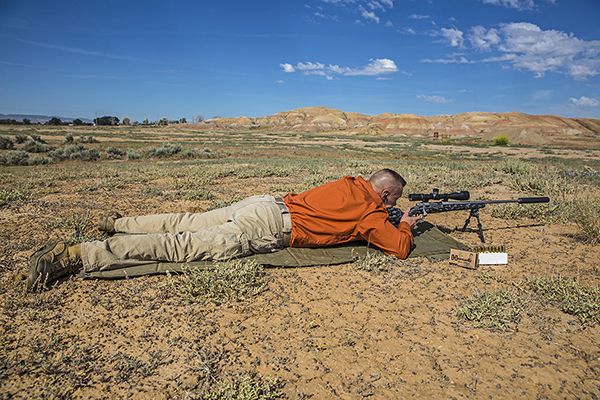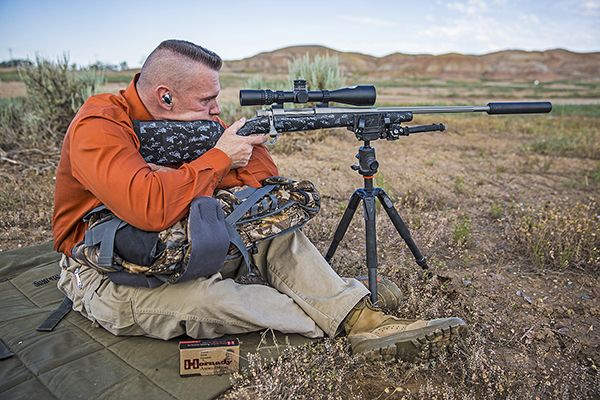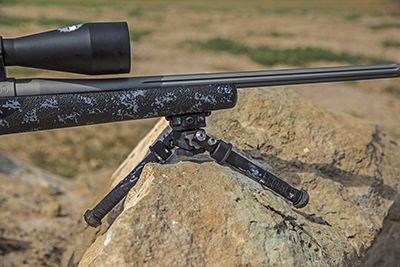When that once in a lifetime dream hunt finally comes, you might only get one shot to make your dream come true. There are many factors that can make you miss or make the perfect impact on your animal. Understanding and being able to make the shot from an unconventional shooting position is one of the most prevalent factors other than a poor wind call. You can be assured your shot will be taken from the ground, seated, kneeling or the prone position. Prone is the next best position to shooting off of a bench, but it must be done correctly to make an ethical shot on an animal at extended ranges.
After 26 years in the Army and many of those years as a sniper working overseas in a multitude of environments and terrain, I have found this to be true. Translating my military field shooting techniques over to the long range hunting world has and will continue to aid me in accomplishing the sniper standard of “one shot one kill.” Regardless of my shooting position, I try my best to stay as close to the ground as possible, lowering my center of gravity, and in turn, enhancing my stability. Also a key to field shooting is knowing your limitations, what works for what ranges, and practice them as much as possible. Bottom line, at this point in our lives we should stay away from bench shooting all together and practice field shots. Like you, I don’t carry a bench to the field, so I should train like I fight, or in this case hunt!
Prone Supported Position - accurate to 1,000-yards or more.
- When lying in the prone, place your body as directly behind the rifle as the terrain allows. This will allow the recoil to go directly into your shoulder and chest area and give you as much consistent free recoil as possible. If you have the rifle in your bicep and too much angle on your body the recoil will not be the same from shot to shot which will cause a point of impact (POI) change.
- Next, load your Bipod by pushing your body against the rifle buttstock. If you can lift your body up like a pushup and the rifle stays in your pocket then your forward pressure is enough. The rear bag must be squeezed tight enough to not allow the rear of the stock to have any downward movement during recoil, which could cause a vertical stringing shot. I see this as the main cause of high impact from my students. In the same respect, place your chin on the stock and slide it down until your jawline reaches the point of cheek weld. Apply downward pressure from your cheek, to stock, to bag, making sure the stock is firm against the rear bag and keeping your head as vertical as possible. If your rifle stock is not firm against the rear bag, recoils will cause the stock to drop and have a high POI strike.
- When in position, place your crosshairs on the target, close your eyes, take a breath and let it out to your natural respiratory pause. Then, open your eyes. If your cross hairs have moved left or right, reposition your body and try again. Never pull the rifle to the center, adjust your body position to align the cross hairs, this is known as natural point of aim (NPOA). If your rifle is to low on your pocket and you can not get a good field of view or sight picture, raise your bipod or place your bipod on a bag if needed for high angle shots. Lastly, ensure your rifle is not canted or your impact will be off. Keep in mind in some cases a backpack can be used to replace the bipod.
Seated Tripod and Rear Sticks Supported Position - accurate to 1,000-yards or more.
When you are shooting in taller foliage or uneven terrain, a supported seated position is an excellent long range shooting platform to ensure accurate shot placement. Place your rifle in a front support tripod and sit with your ankles crossed slightly. Make sure the tripod legs are horizontal to you for straight back recoil. A leg in the middle will cause tilting left or right during recoil and cause an impact shift in the same direction.
Place shooting sticks over your legs and under the buttstock. Make sure to keep the sticks as vertical as possible so during recoil the rifle does not rise or fall and cause a vertical impact shift. Slide the sticks back or forward to raise or lower the rear stock for elevation sight alignment. You can lean in slightly to make sure the rifle buttstock is against your body. Do not pull the stock to hard into your body and cause the rifle to torque right or left causing cant. Tour bottom two fingers is enough pressure.
Lastly, ensure your rifle is not canted or your impact will be off.
Seated tripod and Rear Bag Supported Position - accurate to 400-600-yards.
When you are shooting in high grass or rocky terrain the prone bipod position may not work. A seated position with a bag support is an excellent long range shooting platform to ensure accurate shot placement in tall grass. Place your rifle on a front support like a rock, tripod or whatever is needed to support the front of the rifle and clear any obstacles from the bullet's path. Sit with your ankles crossed slightly but knees spread out. Place you backpack or rucksack across your knees and a rear shooting bag on the rucksack under your buttstock. Squeeze the rear bag for elevation and if you can, lean in slightly to make sure the rifle buttstock is against your body. Again, make sure when using a tripod to ensure the legs are horizontal to you for straight back recoil. This position is not as stable as using sticks under the butstock, but in some cases it’s all we have. I have used it with great success, but you need to practice it. Also a full backpack will help in stabilizing the rear stock.
Log Sticks Supported Position- accurate to 1,000 or more.
When shooting off a log, whether it is at angle or horizontal, if you pivot and cross scissor your bipod to lay over the log it will force the rifle to lock in and not slide off. Sit or kneel if possible. If kneeling, right handers bring your right knee up and opposite for left handers, then place your elbow on your knee. Use the shooting sticks in the rear just like we did in the seated tripod position. If no rear sticks are available, you can use your support hand in a “V” shape to lock your buttstock into your shoulder, helping it not to drop during recoil. Place your elbow on your knee for support. Again pay close attention to your rifle cant, it will move your impact left or right.
Long Range hunting is challenging and at times difficult, by practicing these and other field shooting positions your chance of a clean and ethical kill will greatly increase.




Shooting Positions